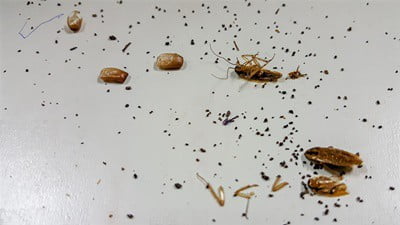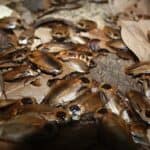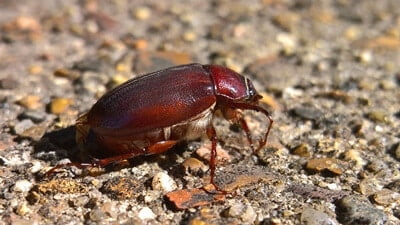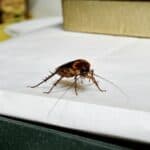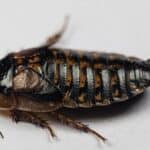Cockroach poop isn’t easy to identify. It can be confused with droppings from termites, mice, and rats. Likewise, certain poop is tiny and can be mistaken for coffee grounds or pepper. In any case, being able to identify roach poop will help you to remove a pest problem. It can tell you the species, size, and the number of roaches in your home.
Roach poop is identifiable based on its color, size, and texture. Roach droppings should be a dark brown color, waxy in texture, and smear like a thick film. Depending on the species, roach feces may be large, like a grain of rice, or small, like coffee grounds. The droppings may have rounded ends and ridges along the sides.
Cockroach poop will be found in key areas around the home, depending on the species. It’s dangerous for humans to ingest or breathe. As such, you should carefully dispose of and sanitize all roach droppings. People who are immunocompromised or have asthma will be at the most risk from roach droppings.
What Does Cockroach Poop Look Like?
Roach droppings leave many clues about the cockroaches themselves. This can help you determine their species and their size. By analyzing the poop, you can also rule out other pests and better focus your extermination efforts. When identifying cockroach poop, look for 3 main characteristics:
Color
Cockroach droppings have a stark, dark brown color. It might even look black, depending on the diet of the roach, the age of the droppings, and any surrounding contaminants.
Unfortunately, the color does not vary between cockroach breeds. Analyzing this won’t help you identify an American cockroach from a German cockroach, for example.
Size And Shape
Instead, you can narrow down the species by the size and shape of their droppings. As you may expect, small cockroaches leave small poop. Larger breeds will scatter large droppings around your home.
Small Cockroaches
Little roaches share characteristics in their poop. The droppings will be tiny black specks scattered across an area. In fact, it may seem like you spilled coffee or ground pepper on the floor. Upon closer inspection, you’ll discover that the droppings are round.
Large Cockroaches
For large species, such as the American or Oriental roach, their waste will be like rice grains. They’re shaped like solid crystals or cylinders. The ends will be rounded, with ridges along the sides.
These droppings are often confused with rat or mice droppings. You may require a magnifying glass to notice the differences. While that sounds excessive, putting out mouse traps by mistake will only let your cockroach infestation grow uncontested.
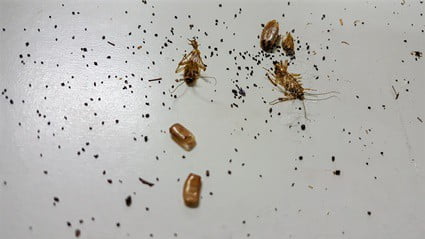
Texture
If the droppings are not whole, they may look like smears or stains. Cockroach feces have little water content, so they will not soak into fabric or other surfaces. Instead, the mark will be raised. You may need to inspect them more closely, as small droppings will seem like ink stains. Here’s what to do:
- Put on a rubber or latex glove for hygiene purposes.
- Gently smear the dropping. It will wash out of fabric, so don’t worry about damaging your clothes or towels.
- Upon doing so, you’ll find it’s not entirely smooth, like ink. The poop will smear unevenly with a waxy texture.
In contrast, rat or mice droppings will smear but in a greasy, wet fashion.
Cockroach Poop Vs. Other Pests
Termites, mice, rats, and cockroaches all have similar poop. Each animal is a pest that should be dealt with, but they all require different approaches. Before you take action, examine the waste for these differences.
Difference Between Mouse and Cockroach Poop
Mouse droppings display these characteristics. They’re:
- Bigger than cockroach poop, even with large cockroaches
- Have short hairs in them, while roach poop doesn’t
- Have pointed ends, not rounded ones like cockroaches
Cockroach Poop Vs. Termite Poop
Termite droppings also look like cockroach droppings in size and texture. However, these traits will set them apart:
- Termite poop is multicolored, while roach poop is brown or black.
- The poop is pellet-shaped, not rice or coffee-ground shaped.
- The poop is six-sided, lacking a roach’s clean cylinder shape with ridges.
- Termite poop is almost exclusively found in or near wood. Roach poop can be found anywhere.
The color of termite poop also depends on the color of the wood they’ve eaten. While cockroaches can eat wood, it’s an unlikely target in a food-rich house.
Difference Between Rat And Large Cockroach Poop
Rat poop will be:
- Much larger than cockroach poop, even if your roaches are large.
- Much thicker, whereas large cockroaches will only produce waste the size of a rice grain.
- About the same length as mice droppings and far longer than cockroach poop.
- Pointed at the end, not rounded.
Where To Look for Cockroach Droppings
Cockroaches often defecate at random. They won’t designate certain areas as private bathroom spots. However, it’s natural for cockroaches to poop where they spend the most time. This will be near their feeding and nesting areas. Why is this important?
- Locating the nest will help you eradicate the infestation.
- If it’s one or two cockroaches, knowing their feeding area can help you cut off this food supply. The cockroaches will then leave or starve.
So, where should you look for cockroach droppings to track down these pests?
Kitchen
The kitchen is a prime location for roach droppings and the roaches themselves. They will stay near a food supply, so look through:
- Kitchen cabinets
- On shelves
- In drawers
- Behind or under your refrigerator
Cockroaches like to hide, so look in all the nooks and crannies of your kitchen.
Laundry Room
The laundry room is a warm, moist area due to your washer and dryer. It may also be full of clothing that will hang dry, adding greater moisture to the air. Finally, it sees little foot traffic in contrast to the rest of your house.
These elements are all ideal for roaches. That’s why you’re more likely to find a nest here rather than in your kitchen. You should seek out droppings:
- Underneath your washer and dryer.
- Beyond bottles of detergent or fabric softener that’s rarely used.
- Inside cupboards or on shelves.
- Behind or under objects that aren’t regularly moved, like storage containers.
Bathroom
Cockroaches may sneak into your home through leaky pipes. This can lead roaches to your bathroom, which is a moist, warm, and quiet place. Here, they’ll feed on soaps, hair, or even toilet paper. Be sure to check:
- Around the base of your toilet
- Near drain pipes. For example, the ones that lead under your bathroom sink
- Inside cupboards, especially around soaps, toothpaste, or toilet paper.
- Behind your trash can, or even inside
Storage Rooms
Speaking of dark and quiet, be sure to check your storage rooms. These may include:
- Attics
- Closets
- Wardrobes
- Anywhere in your home where boxes, clothing, and other objects are left unattended.
Storage areas provide a cockroach with shelter and darkness. These are two great elements when avoiding detection from humans or pets.
When investigating these spots, be sure to bring a flashlight and check all the corners. If you’re dealing with small cockroaches, you may overlook their droppings. It’s easy to mistake it for dust or debris from other items unless you look closely.
Cracks and Crevices
Cockroaches can be as little as a ½ inch long. Because of this, they get into all sorts of places and leave their droppings. Check the unsuspecting areas, such as:
- In between electronics
- Behind furniture
- Near baseboards
- Around the garbage can
- Around light switches and electrical outlets.
If you have any cracks in your walls, make sure to look there, too.
What Do Different Types of Cockroach Poop Look Like?
So, you’ve found the poop. You’ve determined that it’s cockroaches. You know if it’s a large or small species. Now it’s time to narrow down the exact cockroach you’re dealing with. By understanding the kinds that are terrorizing your home, you can pick the right extermination method.
German Cockroach
The German cockroach is one of the smaller kinds, at only ½ inch in length. It’s oval in shape. Along with the brown-banded cockroach, it’s the second most common home-based pest in the U.S. They share many of the same habits, and their poop looks the same.
The German roach’s main identifying feature is the two parallel lines that run across the back of its head. These reach to the base of its wings.
Where Is It Found?
German cockroaches struggle in cold weather, so they seek warm, food-rich havens, like your home. As such, you’ll find them in a:
- Laundry room
- Bathroom
- Anywhere that’s humid
Droppings
For German cockroaches, you’ll see their poop before you ever see them. They are nocturnal, happy to scurry around when people are asleep. Their small size also makes them very quiet, difficult for humans or even pets to detect.
German roaches only appear in the day when their nest is overcrowded or has been disturbed. Their droppings are:
- Small
- Look like coffee grain or pepper
- Will smear black or brown
- May appear as dark spots in the corners of rooms
American Cockroach
The American cockroach is significantly larger than the German cockroach. It ranges between 1 and 2 inches in size. It’s usually reddish-brown in color. There will be light yellow on the edges of its thorax.
Where Is It Found?
The American roach is usually found in:
- Crawl spaces
- Basements
- Drains
Droppings
For the standard adult, the droppings will be:
- Long
- Shaped like cylinders
- Have ridges from tip to tip
- Be rounded on either end
Young American cockroaches will have smaller poop because of their smaller size. It will look like a piece of brown or black rice.
Oriental Cockroach
The Oriental cockroach is an inch long and dark black in coloring. It’s a bit smaller than the American roach but considerably larger than the German roach. It’s quickly recognizable by its thick body and ridged back.
Where Is It Found?
This species prefers very wet areas, far more than its cousins. While Oriental roaches can survive a month without food, two weeks without water is detrimental. As such, you’ll find them in:
- Basements, especially if it’s recently flooded or leaked. Even those that experience a lot of condensation build-up will be prime targets.
- Bathrooms, especially in the nooks and crannies around a shower or bathtub.
- Kitchens, especially around the sinks.
Droppings
Their droppings are almost identical to the American cockroach. Note that all cockroaches will desire a food source. While the areas described above may be ideal, roaches will still leave these spots to seek food. You may find them in your kitchen, wherever your trash can is stored, or even in snack stores throughout the home.
What Does Cockroach Poop Smell Like?
The smell of cockroach poop may alert you to an infestation. It’s easily detectable to the human senses, but you may need a large quantity first. A few droppings won’t be noticed unless you’re hunting for them. Cockroach poop gives off an odor often described as:
- Misty
- Moldy
- Foul
- Sooty
- Like moth balls
- In rare cases, some people liken it to the smell of almonds
So, does your laundry room or closet smell like mothballs for no reason? You might find cockroaches or their droppings nearby—the more insects, the more poop; the more poop, the stronger the smell.
Why You Need to Get Rid of Cockroach Poop
If cockroach poop is so small and ignorable, you may wonder if you can leave it. If it’s in the corner of your room, in an old box, or otherwise out of the way, why bother cleaning it up. Right? On the contrary, it’s important to clean up roach droppings. If left, they will cause you more issues than expected.
Attraction
Cockroach droppings serve as an invitation for other roaches to enter. Roaches have a keen sense of smell. They’ll detect the presence of other roaches and flock toward them. If there’s an abundance of poop, this indicates a thriving nest. That’s great news to new cockroaches seeking a home.
So, even if you remove the present cockroaches, more will eventually arrive if the poop isn’t cleaned up. Pest control specialists often use this to their advantage. They’ll place traps near the droppings, so they can catch and remove any cockroaches that escaped the first purge.
Health Hazard
A roach’s digestive system retains disease pathogens. The insect will then pass germs or bacteria, like salmonella, into its poop. If you inhale or ingest these contaminants in any way, you may be exposed to harmful diseases. According to the Journal of Food Protection, this can damage your health if there’s regular contact.
Asthma Risks
According to the EPA, the content of roach droppings may also trigger allergy symptoms or asthma. Symptoms often worsen when fans or HVAC ducts cause this debris to become airborne. If children are around it long enough, cockroach dropping can even cause them to develop asthma.
What Exactly Happens If You Eat Cockroach Poop?
No one intentionally eats cockroach poop. However, cockroaches may have snuck their waste into your food with their invasive nature without you noticing. A few black specs can easily be mistaken for seasoning or overlooked altogether.
In fact, have you ever had food poisoning from the food you’ve made? According to the Journal of Medical Entomology, it may have been due to roach feces. When ingested, the droppings can make you quite sick. That’s because cockroaches often retain whatever contaminants they’re in contact with, such as:
- Bacteria
- Mold
- Fungi
- Viruses
- Worms
This is deposited through their feces. When you eat it, all that goes into you, too.
Signs You’ve Eaten Cockroach Poop
Symptoms may not appear for a couple of hours. During this time, the contaminants will try to work their way into your body. Your immune system will mount a defense, which may closely resemble food poisoning. The most common symptoms of ingesting cockroach dropping include:
- Diarrhea
- Stomach pain
- Abdominal cramps
If these symptoms last more than two days or become dehydrated, seek medical attention right away. You may also contract a salmonella infection, which may need immediate attention. No matter what, if you’re in one of the risk groups, call your doctor right away.
Can You Die From Cockroach Poop?
People at the greatest risk will be:
- Children
- Elderly
- Those who are immunocompromised
With weakened immune systems, the various diseases transmitted by a cockroach may run rampant. This could result in death.
Can You Tell How Many Cockroaches You Have By The Droppings?
Several droppings can indicate you have a large number of cockroaches. However, it may also indicate a small number of cockroaches. If they’ve been in your home for a great deal of time, their feces may have built up. To determine how many cockroaches you have, you can perform a test:
- Clean up the poop
- Leave the area undisturbed for a full day
- Check the area again
Has any poop been left during this short period of time?
- If a large amount appears, there’s a sizable cockroach population in your home.
- If only a little appears, you likely have between 1 and 5 cockroaches.
- If no droppings show up, the cockroaches might have left or moved to a different area.
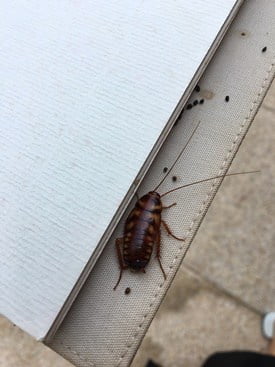
Does a Clean House Mean No Cockroach Droppings?
Cockroaches thrive in dirty surroundings. However, they are willing to invade a well-kept house. It’s not poor housekeeping alone that attracts cockroaches. They may enter your home on:
- Packages of food
- Boxes left on your doorstep
- Appliances
They may even migrate from one home to another out of convenience. While a dirty home will attract them faster, it’s not the only reason for their presence.
What is the Difference Between Cockroach Eggs and Poop?
On average, a cockroach egg will be:
- Very small
- White in color when they are first formed
- Harden and darken as they mature
Over a short amount of time, the eggs will become:
- Dark brown or red-brown
- They may also develop ridges
Unless you take a closer look, this will resemble cockroach poop. If you leave the eggs or clean them up improperly, you may have a mess of new cockroaches on your hands. To tell the difference, look at these factors:
Size
As small as the eggs are, cockroach droppings are even smaller. If you see something brown that’s closer to ¼ inch, it’s probably an egg, not a dropping.
Hiding Place
After that, you’re more likely to find cockroach droppings than eggs. Roaches will hide their eggs to keep them from harm. So, if you do find them, the eggs are probably tucked into dark cupboards, under furniture, in basements, or attic.
If It’s Attached Or Scattered
The eggs may also be securely attached to a surface. This prevents them from getting trampled on or found by predators. For example, the eggs may be underneath your fridge, clinging to the metal underbelly. You won’t just find eggs lying around, but poop is often scattered about.
How to Clean Up Cockroach Poop
Cockroach droppings shouldn’t be swept away without a care. Since roach waste contains many harmful contaminants, you need to approach clean-up wisely.
Protect Yourself
Cockroach droppings are most dangerous with skin contact and inhalation. If you touch the droppings with your bare hands, or they brush against you, that’s dangerous. The contaminants are now on your skin and may touch food, your mouth, or other items. Be sure to:
- Wear gloves
- Wear a face mask
- Ventilate the area if you or a loved one has asthma
- Children should also be kept from the area until clean-up is finished
Vacuum Or Wipe
On hardwood or countertops, you can use a wet, sanitizing wipe to clean up the droppings.
On carpet, use a vacuum to clean up the droppings. Ideally, this will be a vacuum with some form of air filtration. It should not allow the contaminants to become airborne. If your vacuum is old, in bad repair, or lacks a filter, be sure to keep the room well ventilated.
If someone in your household has asthma or is immunocompromised, consider investing in a new vacuum. Inhaled droppings can be dangerous or even fatal. Be sure to clean up all evidence of droppings. Affected areas may include:
- Walls
- Clothing
- Furniture
- Carpet
Throw Away Droppings Securely
With a cleaning wipe, immediately deposit it and the droppings into a trash bag. It may be wise to keep the bag close by, so there’s no danger of spilling in transit.
With a vacuum, empty the collection cup into a trash bag. It’s wise to do this outside in case the process kicks up dust. You may also want to sanitize the collection cup to be safe.
In both cases, seal the trash bag to keep the bacteria contained. It’s unwise to leave this in your home, adding more trash throughout the day or week. Instead, take it immediately to your trash collection area.
Sanitize The Area
Use soap and warm water to sanitize the area where droppings were found. If the soapy water fails to get everything, try a citrus-based cleaner and dilute it with water. This will:
- Prevent diseases from staying on the surface.
- Reduce the chances of an allergic reaction.
- Remove pheromones that attract other cockroaches to your home.
If you find the smell lingers, baking soda can help neutralize the odor. After you’re finished, wipe or scrub down the surface with clean water.
Clean All Associated Items
Clothing, mattresses, and other furniture should be sanitized if they’ve touched the droppings in any way. For example, if you find cockroach poop in your closet, be sure to check all your clothes, especially the pockets.
Allergens from roach droppings can persist in the environment for up to 5 years. As such, being thorough may seem like overkill, but it can protect your household.
I See Cockroach Poop, But No Roaches
If you’ve spied cockroach droppings but no cockroaches, this could mean several things.
The Cockroaches Are Good At Hiding
Since they’re nocturnal creatures and quick to flee, droppings may be your only evidence. Try conducting the test described above to determine if they’re still active.
The Cockroaches Are Dead
If you’re mounted a counter-attack against your infestation, then take this as a good sign. The poop may be leftover. Over time, you should start finding dead cockroaches in corners around your home. This will confirm it.
The Cockroaches Have Left
Cockroaches leave when there’s no food source or too many deterrents. If you find poop but not roaches, you may have done a great job scaring them off.
Even if there are no live roaches, be sure to clean up the poop. Cockroaches are still opportunistic and may return if they smell an appealing invitation.
